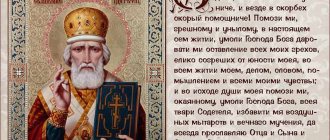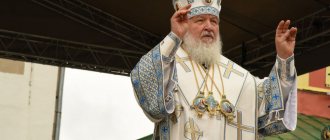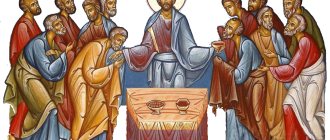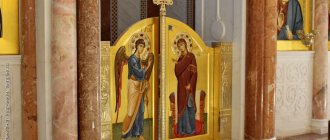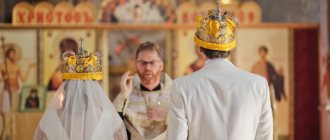Bishops
Photo: Aif.ru
This is the highest sacred rank. Directly translated from Greek, this concept is translated as “bishop” or “overseer.” A clergyman becomes a bishop after the Sacrament of Ordination, otherwise known as Ordination. It is conducted by a council of bishops, that is, several clergy of this rank gathered together.
In the Orthodox tradition, bishops are vested with the same powers as the apostles. They head parishes and are also the immediate supervisors of the clergy. Has the right to conduct all Sacraments without exception.
Bishops are considered equal in grace, however, in order to receive help in difficult situations, some bishops are given additional rights.
Patriarch
This is the bishop who leads the Orthodox Church in the entire state. This title is literally translated from Greek as “family” and “commander.”
At the same time, in some Orthodox countries the church is led by an archbishop, for example, in Poland or Greece. In Georgia and Albania, the Catholicos is the head, and the Alexandrian and Roman churches are ruled by the pope.
Metropolitan
It seems to be translated from Greek as “metropolitan”. A metropolitan is the name given to the leader of a large church region. In Orthodoxy it is called a diocese.
In their structure, dioceses are divided into deaneries, and an even smaller territorial unit is a parish. Metropolitan is an honorary priestly title, which is also a kind of reward for many years of service to the church or special merits.
Archbishop
In early Christianity, the rank of archbishop in the church hierarchy was higher than the metropolitan. Under his direct jurisdiction were several metropolises that were subordinate to him.
Currently, in the Russian Orthodox Church, archbishop is an honorary rank preceding metropolitan.
Bishop
A priest in the rank of bishop presides over a relatively small territory. In some cases, he has an independent area of administration or he may be an assistant to a senior bishop. In this case, he is called vicar. That is, he himself does not have his own diocese to manage, but is obliged to help the local bishop in leadership.
Priests
Photo: Aif.ru
This is the next level of priesthood, the name of which comes from the Greek words “elder”, “leader of the community”. It is among them that black and white clergy are distinguished.
Secular clergy
Those who belong to the white clergy have the titles:
- protopresbyter - this title is awarded to visibly highlight one of the priests for many years of honest service or especially outstanding services.
- archpriest - from Greek this word is translated as “first priest.”
- priest.
Black clergy
Representatives of the black clergy have the titles:
- archimandrite - in modern practice, is the head of a significant or large monastery. In the days of early Christianity, this was the name given to a person who led several monasteries at the same time, for example, throughout the entire metropolis at once. In some situations, a clergyman was made an archimandrite as a kind of reward. If we talk about the white clergy, then this title corresponds to the position of protopresbyter, as well as archpriest.
- abbot - from Greek this title is translated as “leading”. He is considered the immediate leader of the monks, in ancient times and currently the abbot of the monastery. In some local Orthodox churches, this title is used as a kind of hierarchical reward. This practice in the Russian Orthodox Church was finally abolished in 2011.
- hieromonk - a priest of monks.
WHO IS WHO IN THE CHURCH - HIERARCHY, TABLE OF RANKS
Autocephaly (gr. - self-leadership) - independence, self-government of the Orthodox Churches (Constantinople, Jerusalem, Russian, Serbian, Greek, Cypriot, Bulgarian, Romanian and others).
Archbishop (Greek) – senior bishop.
Bishop (Greek) – senior over the priests (priests). A person of the highest (third) degree of priesthood: bishop, archbishop, metropolitan, patriarch.
Archimandrite (Greek) – the highest monastic rank. A monk who has this rank can be consecrated to a bishop.
Father is the traditional title for a priest in Orthodox Russia.
Blessing is making the sign of the cross over someone.
The dean is a priest appointed to assist the bishop in monitoring the activities of the clergy and the life of the parishes in the part of the diocese entrusted to him - the deanery. There are also deans in monasteries.
Vicar (from Latin - deputy) - a bishop who helps the archbishop or metropolitan in the affairs of managing the diocese.
Deacon is the first degree of clergy from apostolic times. Deacons are assistants to priests during divine services.
Clergy are ministers of the Church who have spiritual rank, received by them at initiation (ordination), which gives the right and grace to perform divine services and sacraments of the Church. It has three degrees (see Degrees of the priesthood): diaconate, presbytery and episcopate. The clergy is divided into white and black. White clergy includes deacons and priests who are married; to the black clergy - deacons and priests who have accepted monasticism (they are called respectively: hierodeacon and hieromonk). Only a representative of the black clergy can become a bishop (bishop, archbishop, metropolitan, patriarch).
A diocese is a territory in ecclesiastical terms subordinate to the bishop. It is divided into deaneries, each of which consists of several parishes.
Bishop (Greek - overseeing) - bishop, chief shepherd of the diocese (See Degrees of the priesthood). Can perform all the sacraments, including the sacrament of ordination to the deacon and priesthood.
Hegumen (Greek - leading) - a monk in the rank of priest, a rank higher than hieromonk, but lower than archimandrite.
Abbess is the abbess of a female Orthodox monastery.
Hierarch (Greek - priest) - a representative of the highest clergy, bishop: bishop, archbishop, metropolitan, patriarch.
Hierarchy (Greek - hierarchy) is a common name for all three degrees of the priesthood: deacon, presbyter (priest) and bishop (see Degrees of the priesthood).
Priest (Greek) – priest, clergy ordained to the second degree of priesthood. Can perform all the sacraments, except the sacrament of ordination to the priesthood.
Hierodeacon is a monk with the rank of deacon.
Hieromonk is a monk with the rank of priest.
A subdeacon is a minister of the Church, lower in position than a deacon. During the bishop's service, the subdeacons vest the bishop, place eaglets under his feet - special rugs on which he must stand, hand him a dikiri, trikiri, a staff, etc.
Laymen are ordinary believers.
A metropolitan is a bishop of a very large ecclesiastical region.
Abbot is the senior clergyman in a monastery or church.
Neophyte (Greek - convert) - a newly baptized, new member of the Church.
Patriarch (Greek - ancestor) - high priest, highest priest (bishop) of the country. Patriarchs of the Russian Orthodox Church
Presbyter (Greek – senior) is the ancient name of a priest, a clergyman ordained to the second degree of priesthood (see Hierarchy).
A parish is a church community united around one church.
Protodeacon is the first or chief deacon in a diocese.
Archpriest - senior priest (priest), usually the rector of the temple. The title is complained of as an honorary one for services to the Church.
The saint is a bishop.
A priest is a minister of the Church, ordained to the second degree of priesthood and has the right to perform divine services and six of the seven Christian sacraments: baptism, confirmation, Eucharist, repentance, marriage and consecration of oil.
Seminary (Latin - nursery) - an educational institution for the training of clergy.
The Synod of the Russian Orthodox Church is an advisory body under the Patriarch, consisting of the highest hierarchs.
The Holy Governing Synod is a church government body established by Peter I after the liquidation of the patriarchate in 1721. It was headed by a government official - the chief prosecutor, who actually led all the activities of the Church. This was done to subordinate the Church to state power. The Synod lasted until 1917, when the patriarchate was restored.
The degrees of the priesthood are the three degrees of the sacred hierarchy established by the apostles: deaconal, presbyteral (priestly) and episcopal. Deacons assist priests and bishops in performing divine services, but they cannot serve or perform the sacraments on their own. The service of a deacon adorns the service, but is not obligatory - the priest can serve alone. A deacon among monastics is called a hierodeacon. The first deacon serving under the bishop is called protodeacon (or archdeacon, if he is a monastic). Presbyters (priests, in Greek - priests) upon ordination receive the grace to perform divine services and sacraments (except for the sacrament of ordination of new priests). Senior priests are called archpriests. Priest-monks are called hieromonks, the eldest among them are abbots, and the eldest are archimandrites. Bishops (bishops) receive the highest degree of grace. Bishops are equal in degree of grace, but according to their administrative duties they are divided into bishops, vicars, archbishops, metropolitans and patriarchs. Bishops, in addition to performing all divine services, can ordain deacons and presbyters, consecrate chrism, antimensions, and churches; manage church affairs in the dioceses entrusted to them. In modern church practice, candidates for bishops are chosen exclusively from the monastic rank, and the consecration of bishops is carried out by several bishops. (See also Questions about church hierarchy and Questions about church etiquette)
An exarch is a bishop invested with the power to govern a particularly large church district.
Add a comment Cancel reply
Deacons
Photo: Aif.ru
White clergy
- deacon
- protodeacon - senior deacon
Black clergy
- hierodeacon
- archdeacon - senior hierodeacon
This is the third degree of priesthood in the Russian Orthodox Church. In monasticism, the analogue of deacons are hierodeacons.
These priests do not have the right to perform and conduct the Sacraments. Their task is to organize assistance to priests and bishops during the celebration of the Sacraments.
In cathedrals there is a position of senior deacon, who is called protodeacon. The senior deacons in monasteries are archdeacons. It is worth noting that receiving this title indicates primacy of honor, but not power.
Three groups of Orthodox ranks
The Russian Orthodox Church has a three-tier hierarchy, which arose at the dawn of Christianity.
The Orthodox people are divided into 3 types - depending on the degree of closeness to church sacraments and on their powers.
Lay people
These are ordinary Christians who believe in God and have not taken on the clergy. They are allowed to carry out some rituals themselves at home (for example, the consecration of an apartment). The laity are also close to the church and God through prayers, rites of baptism, weddings, funeral services for loved ones and the Orthodox faith. Also, ordinary believers are the bulk of the participants in all services.
Clergymen
They are dressed in clothing appropriate to the rank, but do not belong to the main hierarchy of clergy. They are ordained by ordination (with the blessing of the bishop/rector of the temple) and subsequently become assistant clergy:
- the subdeacon helps the bishop in divine services (nowadays, students of theological seminaries more often become subdeacons);
- the psalmist (otherwise a reader, singer) reads prayers and sings during the service;
- A sexton (otherwise a sexton, an altar boy) can perform one or more of the following functions: ring the bell to call for services, assist the priest at the altar.
Clergy
They perform the sacraments of worship, call the laity to the Christian faith, and generally manage the affairs of the church.
The clergy may be as follows:
- “White” - those who are allowed to have a family, children (but some of them still take a vow of celibacy).
- “Black” - monks who have taken monastic vows, without a family. Only monks are allowed to manage the parish.
At the dawn of Christianity, sextons and clergy were guardians of church property and holy places. Their duties also included lighting lamps, preparing utensils for worship, bringing holy water, blessed wine and bread to the service, and cleaning the church. Nowadays, these functions are divided between cleaners, watchmen, and novices.
In ancient times, there was another rank - deaconesses, who cared for sick women and helped in preparation for the rite of baptism.
Clergymen
It is also necessary to identify clergy in the Orthodox Church. This is the lowest level in the church hierarchy. These include:
- readers (they are also called psalm-readers);
- subdeacons (deacon's assistants);
- singers (sacristans);
- altar servers (cleric bearers or sextons).
Church ministers have the right to read and sing during Divine services - everything except the Gospel. They also keep the temple neat and clean.
( 38 ratings, average: 4.68 out of 5)
